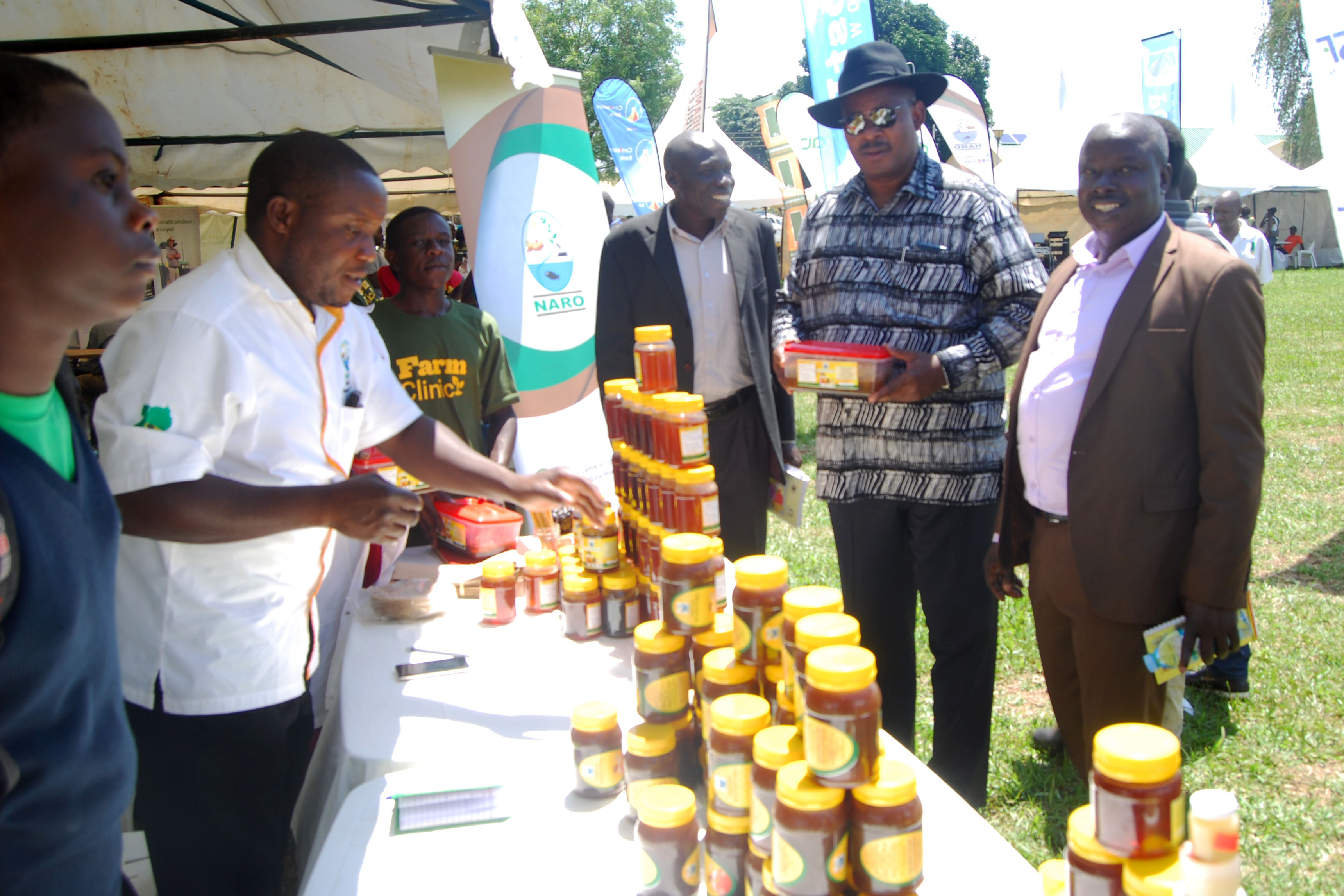Prime
It is more than just honey

Former Naro director general Agona (wearing a hut) inspects a stall of a honey exhibitor during the Seeds of Gold Farm Clinic. Photo/File
What you need to know:
- Your honey can taste either like sugarcane or coffee, depending on the vegetation that surrounds your apiary. Ideally, honey scent and taste has everything to do with what your bees feed on utmost.
Bee products are mainly traded in the form of pure honey, combed honey, boiled honey, propolis, beeswax and honey wine according to a report released in 2012 by the United Nations Development Programme titled, “Value Chain Analysis (VCA) of the Honey Sub-sector in Uganda.”
With the different varieties of honey produced, honey lovers are definitely in for a sweet treat. Today, the market embraces all types of honey with each bearing its own characteristic taste, flavour and colour while boasting health and offering nutritional benefits.
According to experts, a value chain is crucial in enhancing sustainable bee farming practices because it grows the market base and increases household incomes.
However, they urge consumers to look out for quality bee products adding that, “Honey can also be altered to determine the colouring and thickness. Substances such as water and molasses potentially affect the quality.”
Here, the experts share the determinants that make honey more than just a sweet nutritious diet.
Honey scent
Your honey can taste either like sugarcane or coffee, depending on the vegetation that surrounds your apiary. Ideally, honey scent and taste has everything to do with what your bees feed on utmost.
Moses Kuteesa from Bee farmers crib says, the scent and taste of honey is determined by the nectar source.
He says, “For people in the eastern region around sugarcane plantations, their honey smells like sugarcane as well as the taste. For people with large plantations of coffee, the scent and taste is like coffee.”
He associates these taste and smell formations to be enhanced by a chemical composition of the nectar source.
Phiona Birungi, Programs Manager at The Uganda National Apiculture Development Organisation (TUNADO) says the honey scent and taste is derived from the dominant flowers where bees are picking nectar from. He shares, “If the predominant flowering plant in a season is shea nut trees, then it will pick the taste and scent from it. If it is vernonia or citrus, the honey will taste bitter.”
She also urges bee farmers to be intentional in planting enough foliage around apiaries to influence this outcome.
Kuteesa also tips large scale farmers on mechanisms of creating a unified honey taste. He suggests, “Farmers can determine the taste and smell of honey by growing one variety of crop on a large scale for example coffee or eucalyptus in order to create honey with a rich uniform taste over time.”
Thickness
“Honey will either appear thick or light in any case which is attributed to the moisture content in it,” says Kuteesa.
There are a number of factors that determine honey composure or texture which the expert lists as, “Seasonality; as honey harvested during a rainy season is more likely to be watery with high moisture content of 20percent and above.”
Kuteesa also attributes thickness in honey to regional vegetation such as, “ Western, northern vegetation in Uganda produces thick Honey well as most central parts of Uganda produces honey with high moisture.”
The expert also tips bee farmers on good practices such as, “Farmers should avoid harvesting unripe or uncapped honey, which is harvested before the bees put ingredients and have not drained out the moisture they should,” adding that,
“Honey moisture in Uganda can range from 16percent to 22percent or above. Honey with high moisture content usually ferments.”
Ready honey he recommends is “usually sealed with a white seal in a process called capping hence forming capped honey which is usually thick and mature.”
According to Blessing Mugabi from Mugabi Apiaries, Kabaale District, honey from the Kabaale has the highest level of glucose compared to other regions.
She shares, “It is thicker than the rest and has a natural thickness due to the soils and temperatures.”
The bee farmer says the honey is harvested when thick and normally does not require preservatives as it solidifies and crystallises after a week of harvesting.
The three determinants of honey thickness according to Ms Birungi, “nectar source, honey maturity and season when the honey is harvested. Honey which is harvested before it is sealed has a high moisture content and will in most cases be watery compared to mature honey, honey harvested in the rainy season will in most cases be thinner than honey harvested in the dry season. Some nectar produces thicker honey.”
Colouring
Similarly, to thickness and taste, the colour of honey is formulated by the same factors of vegetative and weather conditions.
Kuteesa says unique colouring is preserved by observing certain bee farming practices such as, “planting vegetation of the same kind on large scale and also grading honey during harvest.”
He explains that grading is done by the colour and type of the comb, “At times, new combs produce light umber coloured honey compared to old combs that are heavy and usually darken the colour of honey.
Colours range from white, golden, amber or dark. Colour is usually determined by the type of flowers visited by the bees and equally influences the taste, as light-coloured honey is more mild and sweet, while darker honey has a stronger taste.
According to Mugabi, the white colouring produced for honey in Kabaale is greatly influenced by the flowering that surrounds the apiary.
She explains, “Our honey is unique in colour as kabaale has a variety of flowers such as moon flower, the sun seed, white or yellow flowers thus producing white honey.”
Birungi says nectar diversity plays a great role in honey colouring since honey obtained from different nectar sources is called multi-floral honey. She shares, “Honey obtained from different nectar sources is called multi floral honey and will tend to have a darker shade than honey from areas with a predominant plant like eucalyptus plantations, bananas, and acacia.”
She adds that the market prefers light amber. However, “There are people who prefer dark honey because of the perceived benefits that come from combining different nectar.”
The expert urges beekeepers to influence the shade of their honey by either planting one type of forage plant to get a lighter shade and/or mix forages for a darker shade





